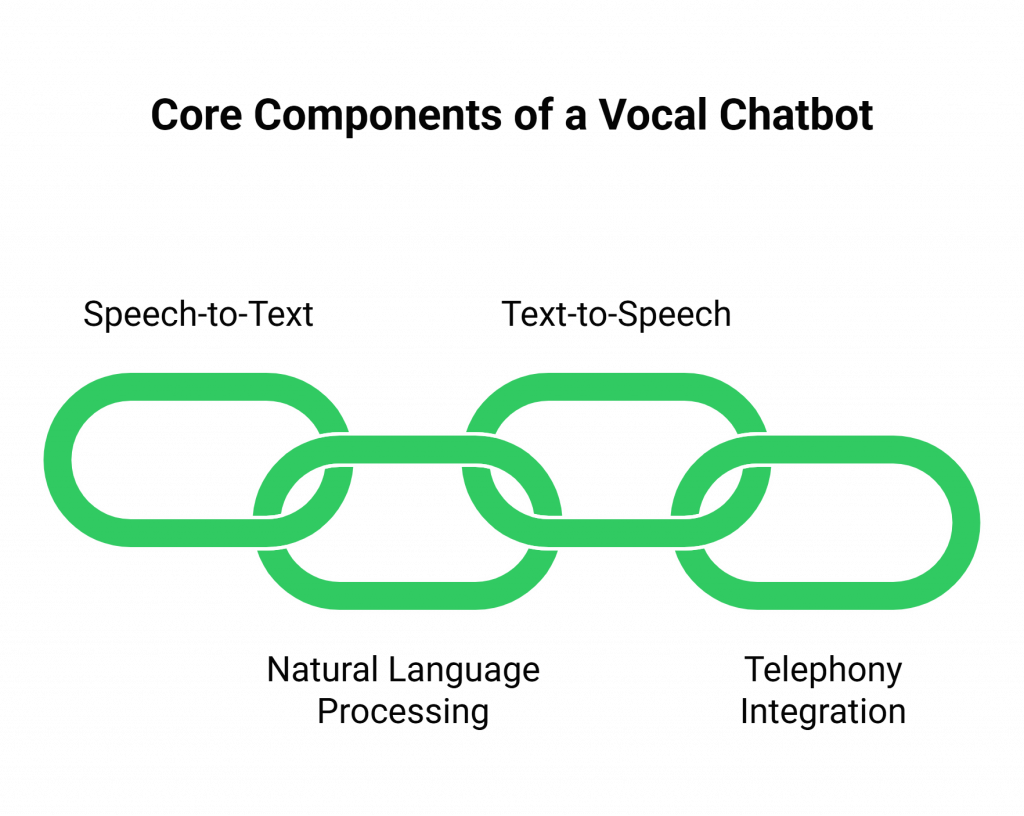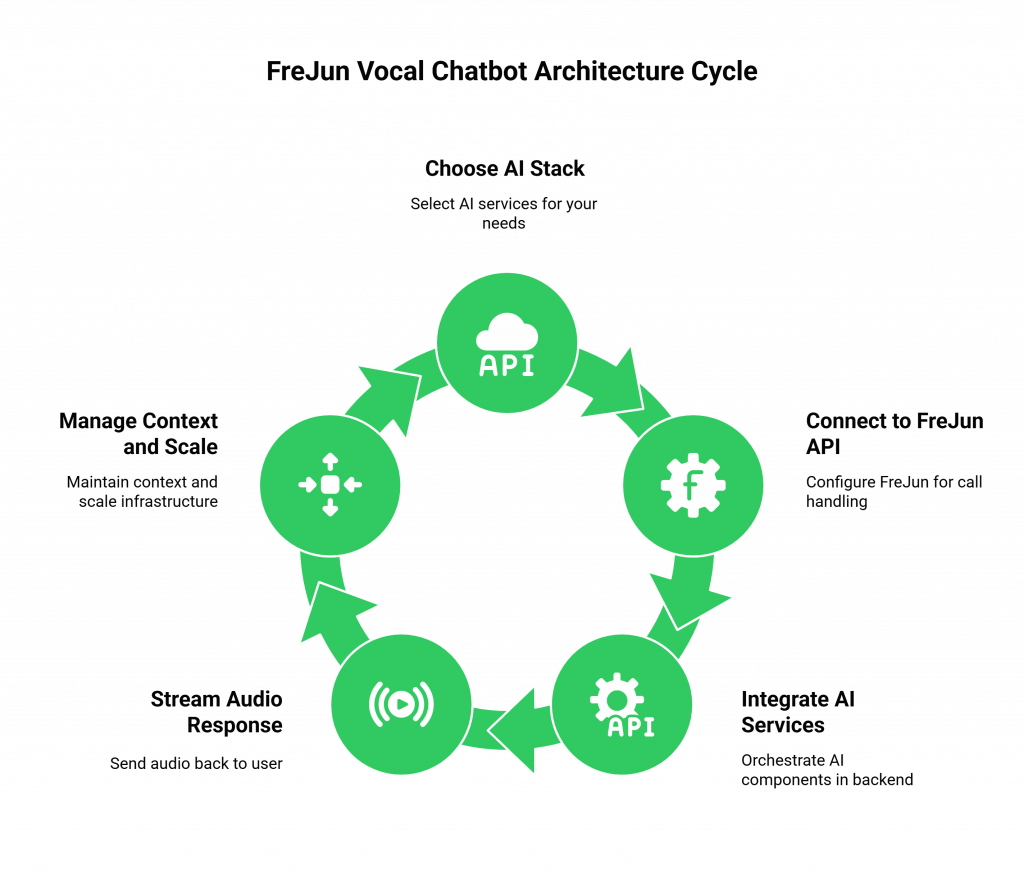Building a voice chatbot takes more than just connecting to an AI like ChatGPT. You need real-time audio, fast speech-to-text, smart replies, and natural-sounding voices, all working smoothly over a phone call. The hardest part? Making all those pieces talk to each other without lag, BUT FreJun AI gives you the voice infrastructure to connect your AI with any phone call. In this article, you’ll learn how to vocal chatbot API and FreJun to build a truly intelligent voicebot.
Table of contents
- The Challenge: Why Building Voice AI is More Than Just an LLM
- What is a Vocal Chatbot API? The Core Components
- The Missing Piece: Solving the Voice Infrastructure Problem
- FreJun: The Transport Layer for Your AI
- How to Build an Intelligent Vocal Chatbot with FreJun (Step-by-Step)?
- FreJun vs. DIY Telephony Integration: A Head-to-Head Comparison
- Best Practices for a Seamless Conversational Experience
- Final Thoughts: Why Does Your AI Need a Specialized Voice Partner?
- Frequently Asked Questions (FAQ)
The Challenge: Why Building Voice AI is More Than Just an LLM
The buzz around advanced Large Language Models (LLMs) and conversational AI is impossible to ignore. We’ve all seen impressive demos of AI that can chat, reason, and even express emotion. This has led many businesses to a logical next step: transforming their text-based chatbots into sophisticated voice agents that can handle customer service calls, qualify leads, or automate appointment scheduling.
The ambition is clear, but the execution reveals a difficult truth. The journey from a text-based AI prompt to a production-grade voice agent that can handle thousands of simultaneous phone calls is fraught with hidden complexities. The real challenge isn’t just choosing the right LLM; it’s architecting the intricate, high-speed infrastructure required to make it talk and listen in real time.
Many development teams dive in, armed with powerful APIs for speech-to-text and text-to-speech, only to find themselves bogged down by the nuances of telephony. They grapple with managing real-time audio streams, navigating arcane protocols like SIP, and battling the one thing that kills a conversation dead: latency. These are not AI problems; they are specialized voice infrastructure problems, and they can derail a project, draining budgets and distracting your top talent from what they do best,building intelligent AI logic.
What is a Vocal Chatbot API? The Core Components
To appreciate the infrastructure challenge, it’s essential to understand the technology stack that powers a modern voice agent. A functional vocal chatbot is not a single piece of software but an orchestrated symphony of specialized services, each communicating via APIs.

Here are the core components:
- Speech-to-Text (STT): This is the chatbot’s ear. An STT engine (like those from OpenAI or Google) receives a raw audio stream from the user and transcribes it into text. A high-quality STT service must handle various accents, dialects, and background noise to ensure the input is accurate.
- Natural Language Processing (NLP) / Large Language Model (LLM): This is the chatbot’s brain. The system sends the transcribed text to an NLP engine (like GPT-4o, Google Dialogflow, or Amazon Lex), which interprets the user’s intent, manages the conversational state, and formulates a logical response. This layer often connects to other business systems,like a CRM or a knowledge base,via internal APIs to fetch relevant information.
- Text-to-Speech (TTS): This is the chatbot’s mouth. Once the LLM generates a text response, a TTS engine (from providers like 11 Labs or PlayHT) converts that text into natural-sounding audio. Modern TTS APIs offer a wide range of voices, tones, and even emotions to create a more engaging user experience.
- Telephony Integration: This is the bridge to the outside world. This layer handles the fundamental mechanics of making and receiving phone calls, managing connections, and streaming audio back and forth over the public telephone network.
Each of these components communicates through a vocal chatbot API, passing data from one stage to the next. The quality of the final conversation depends entirely on how well these APIs are orchestrated and, most importantly, the speed and reliability of the underlying connections.
Also Read: WhatsApp Chat Handling Strategies for Medium-Sized Enterprises in Iraq
The Missing Piece: Solving the Voice Infrastructure Problem
While excellent APIs exist for STT, LLM, and TTS services, businesses are often left to solve the hardest part themselves: the voice transport layer. How do you reliably get audio from a phone call into your STT service and the generated response from your TTS service back to the caller with minimal delay?
Building this “plumbing” from scratch involves:
- Engineering for Low Latency: Even a half-second delay can create awkward pauses and make a conversation feel unnatural and frustrating. Optimizing an entire stack for real-time audio streaming is a monumental task.
- Managing Telephony Protocols: Integrating with the global telephone network requires deep expertise in complex protocols that are fundamentally different from standard web APIs.
- Ensuring High Availability and Scalability: A voice platform must be built on resilient, geographically distributed infrastructure to handle call volume spikes and guarantee uptime for mission-critical applications.
- Maintaining Security and Compliance: Voice data is sensitive. The infrastructure must be secure by design to protect the integrity and confidentiality of conversations.
Attempting to build this in-house distracts from the core business goal: creating a powerful AI agent. You end up spending more time becoming a telecom company than perfecting your customer experience.
FreJun: The Transport Layer for Your AI
This is precisely the problem FreJun was built to solve. We don’t build the AI; we build the super-fast highway for it to run on. FreJun is a specialized voice transport layer designed for speed and clarity. Our platform handles the complex voice infrastructure, allowing you to focus on building your AI, not the plumbing.
We are model-agnostic. You bring your own AI,your preferred STT, LLM, and TTS providers,and maintain full control over your AI logic. FreJun acts as the reliable, low-latency bridge that connects your brilliant AI stack to any inbound or outbound phone call. We turn your text-based AI into a powerful voice agent, ready for production.
How to Build an Intelligent Vocal Chatbot with FreJun (Step-by-Step)?
With FreJun managing the voice layer, the process of deploying a production-grade voice agent becomes dramatically simpler. You can launch in days, not months.

Here is the five-step process for architecting your stack on FreJun:
Step 1: Choose Your Best-in-Class AI Stack
Select the AI services that best fit your needs. You have complete freedom. For instance, you might choose OpenAI for its high-accuracy STT, GPT-4o for its powerful reasoning capabilities, and 11 Labs for its emotionally expressive TTS voices. You will obtain the API keys for each service you choose.
Step 2: Connect to FreJun’s Voice Transport API
Configure your FreJun account to handle your inbound or outbound calls. Using our developer-first SDKs, you set up an endpoint where FreJun will stream the real-time, low-latency audio from the phone call directly to your application backend.
Step 3: Integrate Your AI Services in Your Backend
This is where your unique logic lives. Your application receives the raw audio stream from FreJun and orchestrates the AI components:
- You send the audio to your chosen STT API for transcription.
- You pass the resulting text to your LLM API for processing.
- Your LLM may query internal APIs (CRM, calendar, etc.) to gather context and perform actions.
- The LLM generates the final text response.
Step 4: Stream the Audio Response Back to the User
Your application takes the text response and sends it to your chosen TTS API. The TTS service generates the response audio, which your application then pipes directly into the FreJun API. We handle the low-latency playback to the user on the call, completing the conversational loop seamlessly.
Step 5: Manage Context and Scale with Confidence
Because FreJun maintains a stable, persistent connection for the duration of the call, your backend can reliably track and manage the conversational context independently. As your needs grow, FreJun’s geographically distributed infrastructure scales with you, ensuring high availability and performance without any re-architecting on your part. This entire process utilizes a flexible vocal chatbot API architecture, with FreJun as the core transport mechanism.
Also Read: Virtual PBX Phone Systems Solutions for Businesses in Nigeria
FreJun vs. DIY Telephony Integration: A Head-to-Head Comparison
Choosing the right foundation for your voice AI project can be the difference between a successful launch and a stalled initiative. Here’s how building on FreJun compares to a do-it-yourself approach.
| Feature | FreJun Platform | DIY Telephony Integration |
| Latency Management | Optimized across the entire stack for real-time, conversational AI. | A complex engineering challenge requiring deep audio and network expertise. |
| Time to Market | Days. Our SDKs and APIs accelerate development. | Months or even years. Requires building and testing complex infrastructure. |
| Developer Focus | 100% on AI logic and creating a great user experience. | Divided between voice infrastructure engineering and AI development. |
| Scalability & Reliability | Built on resilient, geographically distributed infrastructure for high availability. | Requires significant investment in redundant servers and network capacity. |
| Call Management | Inbound/outbound call handling, routing, and management are built-in. | Must be developed from scratch, adding significant complexity. |
| Maintenance Overhead | Managed entirely by FreJun’s expert team. | A constant operational burden for your engineering team. |
| Security & Compliance | Enterprise-grade security protocols are built into every layer. | The developer is fully responsible for implementing and maintaining security. |
Best Practices for a Seamless Conversational Experience

Once your architecture is in place, the quality of the user experience becomes paramount. Leveraging a robust vocal chatbot API infrastructure like FreJun is the first step. Here are additional best practices to ensure your voice agent is effective and engaging.
- Prioritize Low Latency End-to-End: A natural conversation requires speed. Pair FreJun’s low-latency streaming with STT and TTS providers that also offer real-time streaming capabilities. This is the single most important factor in eliminating awkward pauses.
- Choose the Right Voice: Your chatbot’s voice is its identity. Use a TTS API that allows for customization of tone, pitch, and emotion to align with your brand. An empathetic voice for a support bot or an energetic one for a sales bot can make a significant difference.
- Plan for Context Management: A great conversationalist remembers previous interactions. Since FreJun ensures a stable connection, design your backend application to track dialogue state, user preferences, and history so it can deliver personalized, context-aware responses.
- Design for Interruption: Humans interrupt each other in conversation. A sophisticated voice agent should be able to handle “barge-in,” where the user starts speaking before the bot has finished. This requires tight integration between your components, facilitated by a low-latency transport layer.
- Ensure Secure Authentication: Every API call in your stack,from voice transport to STT, LLM, and TTS,must be properly authenticated and secured to protect user data and prevent unauthorized access.
- Test and Monitor Continuously: Regularly test the entire conversational flow for accuracy, reliability, and quality. Monitor API performance and latency to identify and address bottlenecks before they impact users.
Final Thoughts: Why Does Your AI Need a Specialized Voice Partner?
The era of monolithic, one-size-fits-all communication platforms is over. The future of AI is modular, allowing businesses to assemble a best-of-breed stack that is perfectly tailored to their unique needs. You should be free to choose the best STT, the most intelligent LLM, and the most realistic TTS on the market.
But to make them work together over a real-world phone call, you need more than just APIs. You need a platform architected for this specific purpose. You need a partner who is obsessed with speed, clarity, and reliability.
FreJun is that partner. By abstracting away the immense complexity of voice infrastructure, we empower you to innovate where it counts,on the intelligence of your AI. Choosing FreJun is a strategic decision to accelerate your time-to-market, reduce engineering overhead, and build a superior voice experience that your customers will love. While there are many components to a vocal chatbot API, the transport layer is the foundation upon which everything else is built.
Transform Conversations with FreJun AI – Try Now!
Further Reading: From Calls to Conversations: Voice-Based Conversational AI
Frequently Asked Questions (FAQ)
No. FreJun is model-agnostic and functions as a specialized voice transport layer. Our core value is handling the complex call infrastructure while giving you the freedom to bring your own preferred STT, LLM, and TTS services from any provider.
You can use any LLM you choose. Our platform serves as the reliable “plumbing” that connects a live phone call to your application. Your application then communicates with any AI or LLM API you want, including those from OpenAI, Google Dialogflow, Amazon Lex, or a custom model you’ve built.
Our entire architecture was designed from the ground up for real-time media streaming. We have optimized every component in our stack, from call ingestion to audio delivery via our API, to minimize delay and eliminate the awkward pauses that break conversational flow.
Yes. Our API is designed to capture and stream real-time audio from any inbound or outbound call, making it the ideal foundation for any voice automation use case, from 24/7 support agents to personalized outbound outreach.
While general-purpose providers offer a broad set of telephony APIs, FreJun is specifically architected as a high-performance voice transport layer for AI applications. Our primary focus is simplifying the integration of your custom AI stack and optimizing for the ultra-low latency that conversational AI demands.
